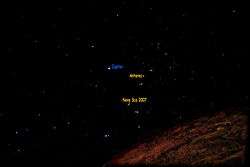V1280 Scorpii
V1280 Scorpii (or Nova Scorpii 2007) is a nova observed in February 2007 in the constellation Scorpius, just south of M62. The nova was a 9th magnitude object when it was discovered independently by Yuji Nakamura and Yukio Sakurai from Japan,[3] around February 4, and peaked at magnitude 3.9 on February 17.
 Nova V1280 Scorpii | |
| Observation data Epoch J2000.0 Equinox J2000.0 | |
|---|---|
| Constellation | Scorpius |
| Right ascension | 16h 57m 40.91s[1] |
| Declination | −32° 20′ 36.4″[1] |
| Apparent magnitude (V) | (+3.9 max) |
| Astrometry | |
| Distance | 5200 ± 1300 ly (1600 ± 400[2] pc) |
| Database references | |
| SIMBAD | data |
Announced by the IAU in Electronic Telegram No. 835 and Circular No. 8803
23 days after discovery, dust formation was found to be occurring in the ejecta, consistent with the classification of the event as a CO nova. This dust formation peaked between 36 and 45 days from the wind that was mainly ejected 10.5 days after the event. On day 100, another brightening was observed, which corresponded to a second mass loss event. The expanding dust shell around the nova has an estimated velocity of 350 km/s.[4]
References
- "NOVA Sco 2007 a". SIMBAD. Centre de données astronomiques de Strasbourg. Retrieved 14 January 2017.
- Chesneau, O.; Banerjee, D. P. K.; Millour, F.; Nardetto, N.; Sacuto, S.; et al. (1 August 2008). "VLTI monitoring of the dust formation event of the Nova V1280 Scorpii". Astronomy and Astrophysics. 487 (1): 223–235. arXiv:0804.4129v1. Bibcode:2008A&A...487..223C. doi:10.1051/0004-6361:200809485.
- Waagen, Elizabeth O. (2007-02-16). "1651-32 V1280 SCO = NOVA SCORPII 2007". Retrieved 2011-03-09.
- Sakon, Itsuki; et al. (February 2016), "Concurrent Formation of Carbon and Silicate Dust in Nova V1280 Sco", The Astrophysical Journal, 817 (2): 23, arXiv:1507.08801, Bibcode:2016ApJ...817..145S, doi:10.3847/0004-637X/817/2/145, 145